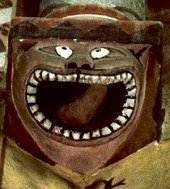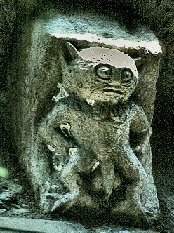LINKS
TO ARTICLES
IN pdf FORMAT
female
exhibitionists:
the
sheela-na-gig conundrum
HIGH-RESOLUTION PHOTOGRAPHS OF MALE AND FEMALE EXHIBITIONISTS
beard-pullers
in the silent orgy
ireland
& the phallic continuum
field
guide
to megalithic ireland
the
earth-mother's
lamentation
beasts and monsters of the mediæval bestiaries
|
FROM ROMAN TO ROMANESQUE by Julianna Lees
NB - This article contains many illustrations and may take some time to download.
|
|
DANIEL IN THE 'DEN' OF LIONS by Tina Negus Early Mediæval Carvings and their Origins. "Your
God himself, whom you have served so faithfully, will have to
save you" These words, allegedly spoken by King Darius the Mede as he had the prophet Daniel thrown into the lion-pit for the crime of refusing to worship him, have echoed down the centuries. Daniel's God did indeed (allegedly) save him, and ever since he has been taken as an example of faith and righteousness, together with Jonah and the three young men in the fiery furnace. His trust in his unique deity and his innocence are seen as a protection against evil. It is not surprising therefore, that images of Daniel are found from the earliest years of Christianity; indeed Daniel may be taken as a prefiguration of Jesus.
|
|
THE GREEN MAN IN THE CHURCHES OF FRANCE AND BRITAIN by Tina Negus Tina Negus is a splendid artist and photographer with a great
knowledge and love of the natural world.
|
|
CELTIC RELIGION by Julianna Lees 'While researching my article on possible Roman and Gallo-Roman iconography for some French Romanesque images, I became aware of the importance of Celtic religion in the evolution of many works of art of ancient France. Here is an article I wrote on the subject, originally for a Study Group of the Aquitaine Historical Society, which foreshadows many of my later observations. The organic growth of iconography, layer upon layer, can be compared to the evolution of a forest from archaic origins, with all the damage both natural and human that occurs. Landscapes change - sometimes unrecognisably - with many things once held dear obscured and forgotten; but tendrils creep back, images recur and echoes may awaken memories of a past that is sometimes still present.'
|
|
ANIMAL SYMBOLISM IN ECCLESIASTICAL ARCHITECTURE by Professor E P Evans We are always hoping to get closer to the mind-set of Romanesque
sculptors, the better to understand some of their images. Bestiaries
may be helpful, so it's useful to know that most of them
are derived from a work of the 4th century known as the Physiologus.
|
A tendentious broadcast on ARTE television proposing that many
grotesque
and 'licentious' motifs in Romanesque sculpture are direct
attacks on Islam,
carved to justify the Crusades.
The proposer of this thesis has but the most superficial acquaintance
with Romanesque sculpture,
and his examples are few and unconvincing.
L'ennemi à nu, de Claudio LANGE.
L'auteur interprète les représentations obscènes
trouvées dans les églises romanes
comme une forme de propagande anti-islamique développée
par l'Eglise catholique pour justifier les croisades.
Thèse stimulante s'il en est ; cependant, ne convient-il pas,
comme le disent les médiévistes,
de voir, encore et souvent, dans certaines images quelque peu licencieuses
une forme de dénonciation du Mal
ou de différentes formes de péché au regard de
l'Eglise institutionnalisée ?
En d'autres termes, ne s'agissait-il pas à l'époque médiévale
d'aider les chrétiens à combattre leurs démons
intérieurs
comme les tentations extérieures ?

